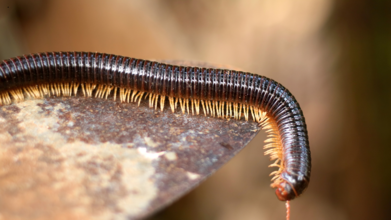- Health Conditions A-Z
- Health & Wellness
- Nutrition
- Fitness
- Health News
- Ayurveda
- Videos
- Medicine A-Z
- Parenting
- Web Stories
Is Regrowing Human Limbs A Possibility Now? Sea Salamanders Study Could Be The Medical Future

Nature is filled with amazing flora and fauna, all with different sets of abilities and unique features. While considered impossible for humans, there are many animals that can regenerate part of their bodies. Sea creatures like starfish and octopuses can regenerate their limbs in case they get hurt or have to decapitate themselves to escape from a difficult situation. Living in the wild, these creatures evolved to adapt to the harsh nature of their surroundings.
This is not the case for humans. Many people have to live without their limbs or organs, whether it is due to being born that way or being hurt/experiencing an accident. However, taking inspiration from one such animal, researchers are looking into human limb regeneration.
Axolotls, with their unique smiles and frilly gills, have become very popular. But these friendly salamanders are more than just cute faces. Scientists are studying them because they might help us solve a big medical mystery: Can people someday grow back lost body parts, like an arm or a leg?
Why Did Researchers Pick Axolotls?
In a groundbreaking study published on June 10 in Nature Communications, Monaghan's team utilized genetically engineered axolotls that glow in the dark to better understand this astonishing process. What makes axolotls so special? They have an incredible ability to regrow any part of their body, no matter how old they are. If they lose a leg, they can grow it right back.
Even if their heart, lungs, or brain gets hurt, they can fix themselves! This amazing ability makes them champions among animals for their extreme healing powers. One of the long-standing questions in limb regrowth has been how cells "know" precisely which part of the limb to rebuild. For instance, if an axolotl loses its upper arm, it regenerates the entire arm. However, if the injury occurs further down the limb, only the lower arm and hand regrow.
Body's Internal GPS
The key to this mystery appears to be a small molecule called retinoic acid, a compound related to vitamin A and commonly found in skincare products under the name retinol. This molecule acts like a GPS, providing cells with crucial positional information, guiding them on where they are on the body and what specific part needs to be rebuilt.
How Retinoic Acid Directs Regrowth
The study's findings were compelling. When axolotls were given a drug that prevented the breakdown of retinoic acid, their limbs regenerated incorrectly, with an upper arm forming where a lower arm should have been. In contrast, axolotls not given the drug regrew their limbs normally. This strongly suggests that retinoic acid precisely instructs cells about their location and what structure to grow.
Hope for Human Healing
While we are still a long way from growing human limbs, this study is a big step in that direction. The scientists believe this research could eventually help people. We all have the same basic genetic instructions for building limbs that we used when we were developing as babies. The challenge now is to figure out how to turn those same instructions back on later in life, which axolotls can do but humans can't yet. This is one of the oldest and most exciting questions in biology. Thanks to the growing interest in axolotls, especially among kids, these unique animals are helping to advance amazing scientific discoveries. It's quite surprising how popular axolotls have become, showing up everywhere from airports to toy stores.
What Does Retracted Eardrum Mean? Here's All That You Need To Know About

Credits: Canva
A retracted eardrum, also called tympanic membrane atelectasis, is a condition where the eardrum gets pulled inward toward the middle ear. Normally, the eardrum (or tympanic membrane) acts as a boundary between the outer and middle ear, transmitting sound vibrations to tiny bones that help us hear. But when it collapses inward, that delicate process can be disrupted.
The condition is often silent at first, meaning people may not realize they have it. But in some cases, it can escalate, causing discomfort or even permanent hearing damage.
Spotting the Symptoms
In most cases, a retracted eardrum doesn’t cause any noticeable symptoms. But when the retraction becomes severe enough to affect structures inside the ear, individuals may experience:
- Earache
- Temporary hearing loss
- Fluid discharge from the ear
If left untreated, a chronic retracted eardrum can lead to permanent hearing loss.
Why Does It Happen?
The most common cause of a retracted eardrum is Eustachian tube dysfunction. These narrow tubes connect the middle ear to the back of the nose and help regulate ear pressure.
When they don’t work properly, pressure inside the ear drops, effectively pulling the eardrum inward.
Some common triggers include:
- Recent or recurring ear infections
- Cleft palate
- A poorly healed eardrum after rupture
- Enlarged tonsils or adenoids
Upper respiratory infections, such as the common cold
How Doctors Diagnose It
Diagnosis typically begins with a discussion about symptoms and any recent infections. A doctor will then use an otoscope, a tool with a light, to look into the ear canal. This allows them to visually confirm if the eardrum is abnormally positioned or collapsed.
Treatment Options: When to Wait and When to Act
Not all retracted eardrums require immediate treatment. In mild cases, doctors often recommend a “watch and wait” approach, as pressure may normalize naturally over a few months.
For more advanced cases, several interventions are possible:
Decongestants or nasal steroids: These can improve airflow in the ear and relieve pressure.
The Valsalva maneuver: This self-administered technique involves closing your mouth, pinching your nose, and gently blowing as if trying to pop your ears. It should be performed under medical guidance.
If the condition begins to affect hearing or causes persistent pain, surgical options may be considered.
Surgical Interventions
Two common surgical treatments are:
Tube Insertion (Myringotomy):
Often used in children with recurring ear infections, this procedure involves placing small tubes into the eardrum to help ventilate the middle ear.
Tympanoplasty:
In more severe cases, part of the damaged eardrum may be removed and replaced with cartilage from the outer ear. This stiffens the eardrum, preventing future collapses.
What’s the Prognosis?
The outlook largely depends on the severity. Minor retractions usually resolve without intervention and don’t cause long-term damage. However, more serious cases, especially those that persist or press against ear bones, may result in hearing loss and need medical or surgical correction.
Experts recommend seeking medical attention if you notice ear discomfort, hearing changes, or frequent infections. Early diagnosis can prevent long-term issues and protect one of your most important senses, your hearing.
Could Millipedes Help Treat Pain And Parkinson’s?

Credits: Canva
In a surprising discovery that bridges the gap between creepy crawlies and cutting-edge neuroscience, researchers at Virginia Tech have identified unique compounds in millipede secretions that could pave the way for future treatments for pain and neurological diseases like Parkinson’s, depression, and schizophrenia.
Led by chemist Emily Meyers, the research team uncovered naturally occurring alkaloids in the defensive secretions of the Andrognathus corticarius, a species known colloquially as the Hokie millipede. The millipede, which lives under decomposing leaves and branches on the university’s Blacksburg campus, produces a chemical cocktail that not only deters predators but may influence neuroreceptors in the brain.
“These compounds are quite complex, so they’re going to take some time to synthesize in the lab,” said Meyers, who specializes in studying underexplored ecological sources for potential new drugs.
A Hidden Chemical Arsenal
The compounds, dubbed andrognathanols and andrognathines by Meyers’ team, belong to a class of complex alkaloids. They were discovered after researchers collected several millipedes from wooded areas on campus and analyzed the contents of their defensive glands using a suite of chemical tools.
The results were striking: some of these secretions had a disorienting effect on ants, one of the millipede’s presumed predators. But that’s not all, several of the compounds were found to interact with a neuroreceptor known as Sigma-1. This receptor has been linked to multiple brain disorders, including schizophrenia, depression, Lou Gehrig’s disease (ALS), and Parkinson’s disease.
In addition to warding off predators, the researchers discovered that the compounds may also serve a social function, possibly helping millipedes signal their location to family members in leaf-littered environments.
From Defense to Drug Discovery
This study, recently published in the Journal of the American Chemical Society, is not Meyers’ first foray into studying arthropod chemistry. She has been collaborating with entomologist Paul Marek, and together, they have previously suggested that the family of alkaloids found in millipede secretions could have significant therapeutic potential.
“Millipedes have been around for hundreds of millions of years. They’ve developed these intricate chemical defense systems, and we’re only beginning to understand their value,” said Meyers.
While the compounds show promise, the next hurdle is a familiar one in drug discovery: scalability. The compounds exist in trace amounts in the wild, and researchers need larger quantities for in-depth testing and potential pharmaceutical development.
The Road Ahead
The team is now exploring partnerships with laboratories that can synthesize the compounds in bulk, which would allow for further testing on their biological activity and medicinal properties. Meyers emphasized that while the research is still in its early stages, the potential applications are broad, from pain management to novel treatments for complex neurological conditions.
“Nature has always been a wellspring of inspiration for medicine,” said Meyers. “And sometimes, the most powerful solutions come from the smallest and most unexpected creatures, like a tiny millipede under a log.”
With this groundbreaking discovery, scientists are reminded once again that the natural world may hold secrets that, once unlocked, could transform human health in unimaginable ways.
Low Grade Prostate Cancer Could Be Increasing Health Risks By 30%

(Credit-Canva)
Cancers are unpredictable and can be either containable or completely wreck your health. To make cancer treatments and research better, healthcare professionals use stages and characteristics, making it easier for us to categorize and identify how far along the disease is. However, recent research has been questioning our stance on this particular cancer, saying it could be worse than what we had believed.
A recent study has found that a specific type of prostate tumor, called Grade Group one (GG1), might not be as harmless as once believed. While many doctors consider these tumors to be at low risk of spreading and recommend monitoring them, the new research suggests the true risk might be higher. In fact, the study indicates that up to 30% of these cases could be more serious than doctors think, and a closer look could save lives.
Challenge with Current Practices
For years, men diagnosed with a GG1 tumor were often told to skip immediate treatment and instead undergo "active surveillance." This means they were regularly checked with blood tests and follow-up biopsies to see if the tumor was growing.
However, researchers point out a key problem: a single biopsy might miss more aggressive cancer cells located in a different part of the prostate. This could lead to a patient being undertreated, which could have serious consequences later on if the cancer grows. The authors believe that relying on just one biopsy to decide on treatment is a flawed approach.
What Are Low-Grade Prostate Tumors?
According to a 2022 review published in the Urological Research Society, the lowest grade of prostate cancer, called ISUP Grade Group 1 (GG1), grows very slowly. Because it is so harmless, some experts have suggested that we should stop calling it "cancer" at all. This has been done before for similar low-risk tumors in the bladder and thyroid.
The review summarized that even though GG1 tumors have some characteristics of cancer, their behavior is much more like a harmless, non-cancerous growth. The authors suggest that renaming GG1 prostate cancer could have several benefits:
- It could help prevent unnecessary treatments.
- It would reduce a patient's fear and stress.
- It could lower the financial costs for patients and the healthcare system.
Study's Findings
Challenging the view of previous studies, researchers sought to get a clearer understanding. To get a more accurate picture, the research team looked at data from over 300,000 men. Among those who were initially diagnosed with GG1 tumors, the team used additional factors like PSA levels and tumor size, which can be better indicators of risk.
By combining all this information, they found that a significant number of men—more than 18,000—were actually at higher risk and should have received more aggressive treatment like radiation or surgery. This data strongly suggests that as many as 30% of GG1 diagnoses might be underestimated, leaving many men without the full treatment they need.
Call for Change
The authors of the study are urging doctors to reconsider how they evaluate GG1 tumors. They emphasize that a "low grade" diagnosis from a biopsy isn't the same as a guaranteed "low risk" for the patient. They believe it's a doctor's responsibility to use all available data to accurately assess a man's individual risk. The goal is to ensure that those who need treatment get it, while still safely recommending active surveillance for the men who are truly at low risk.
© 2024 Bennett, Coleman & Company Limited

